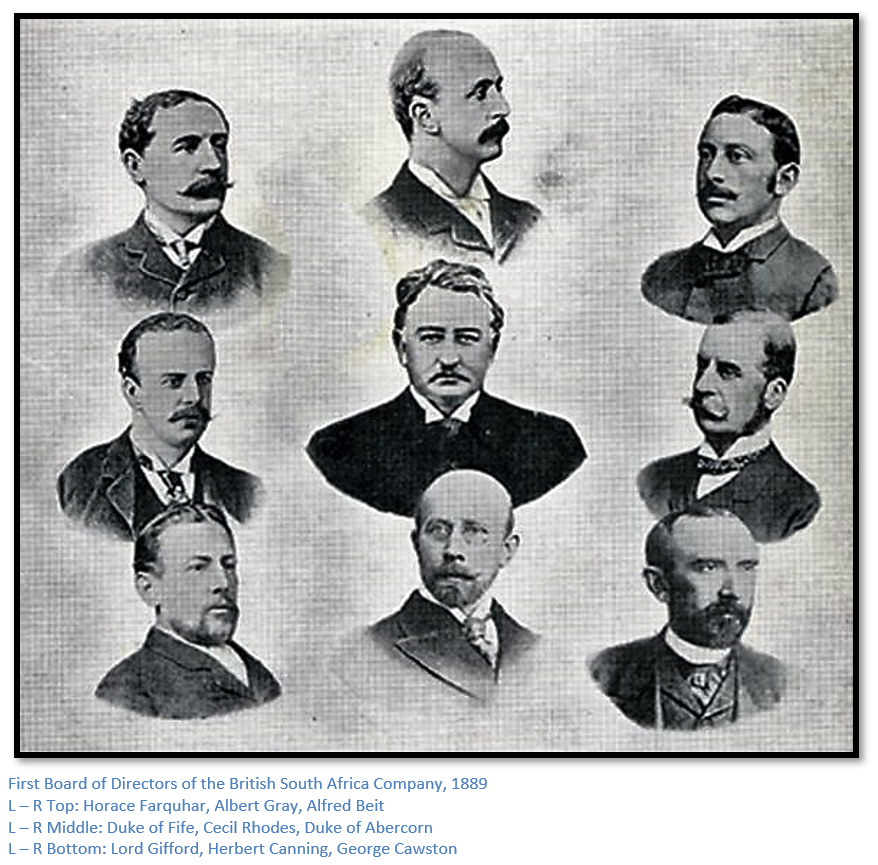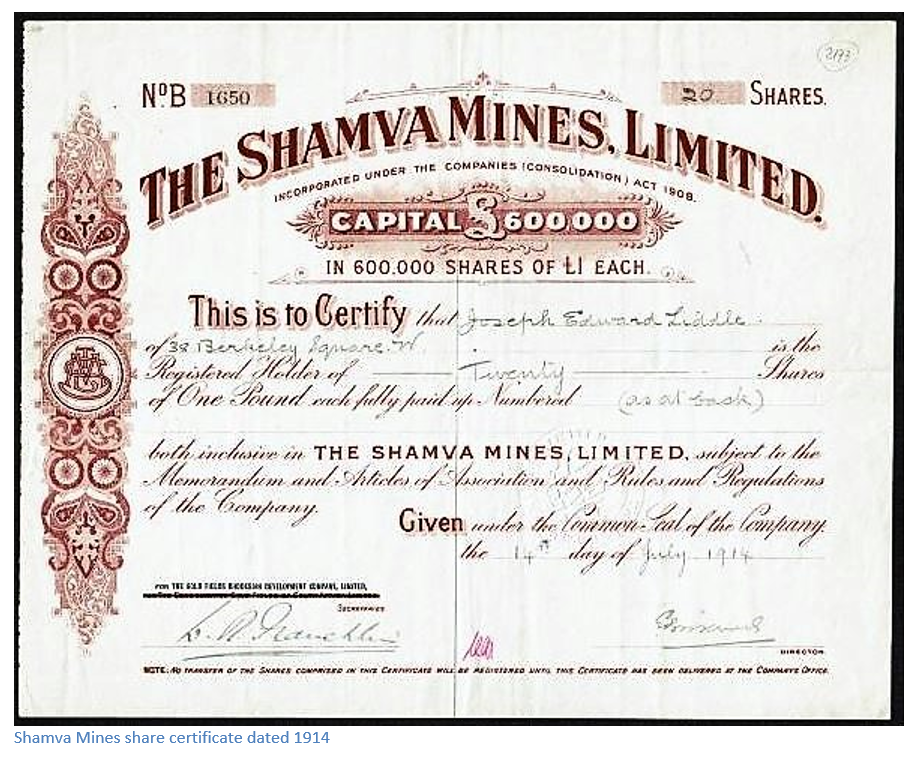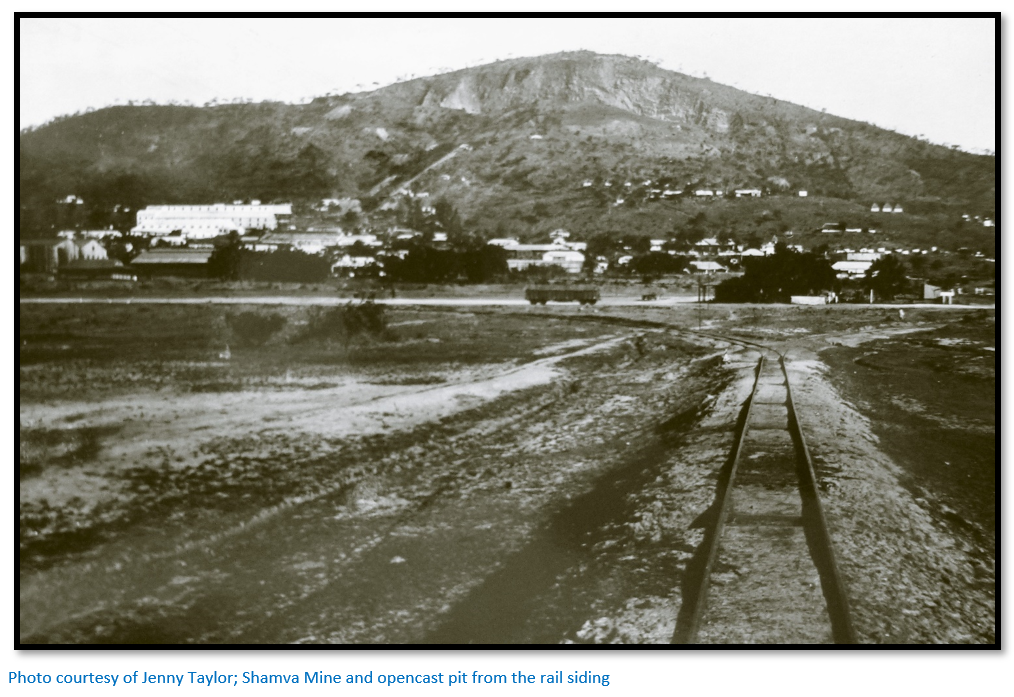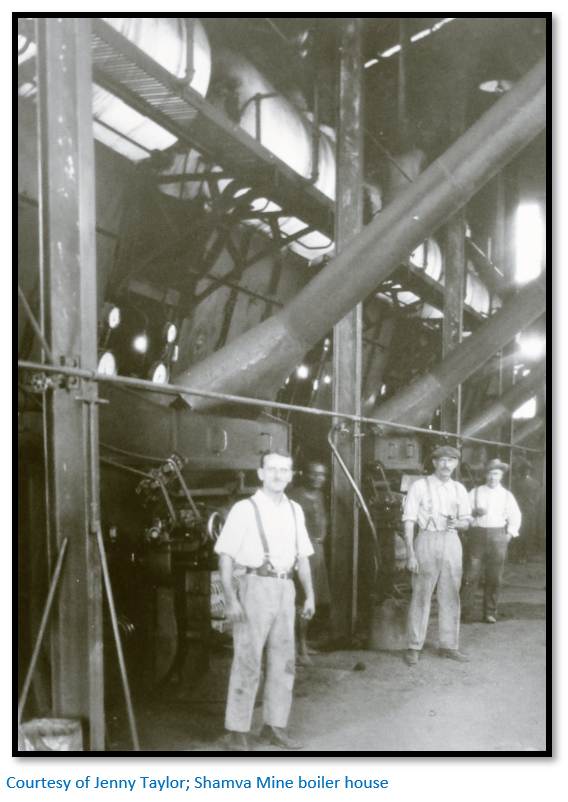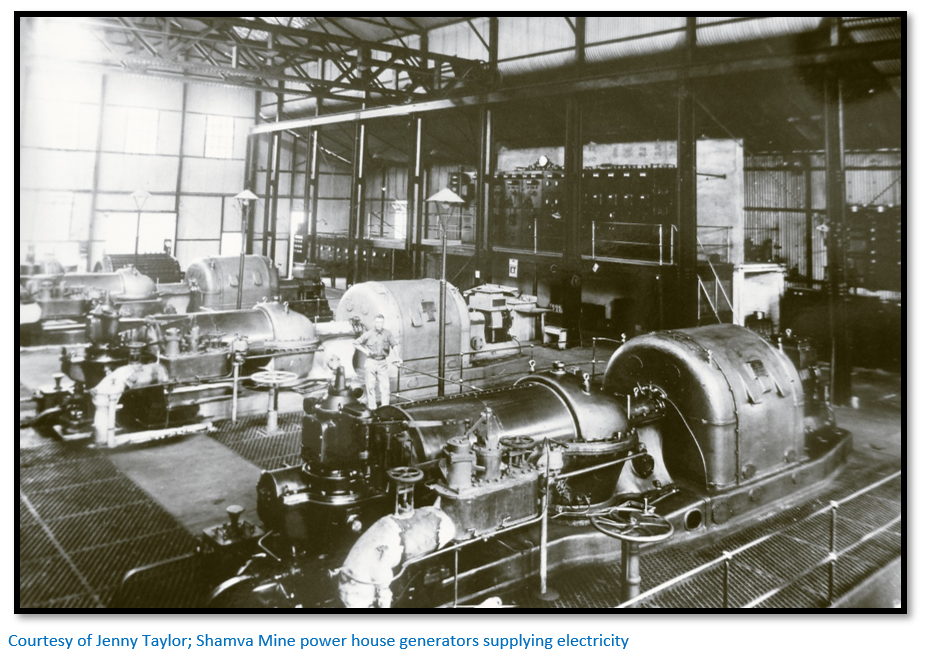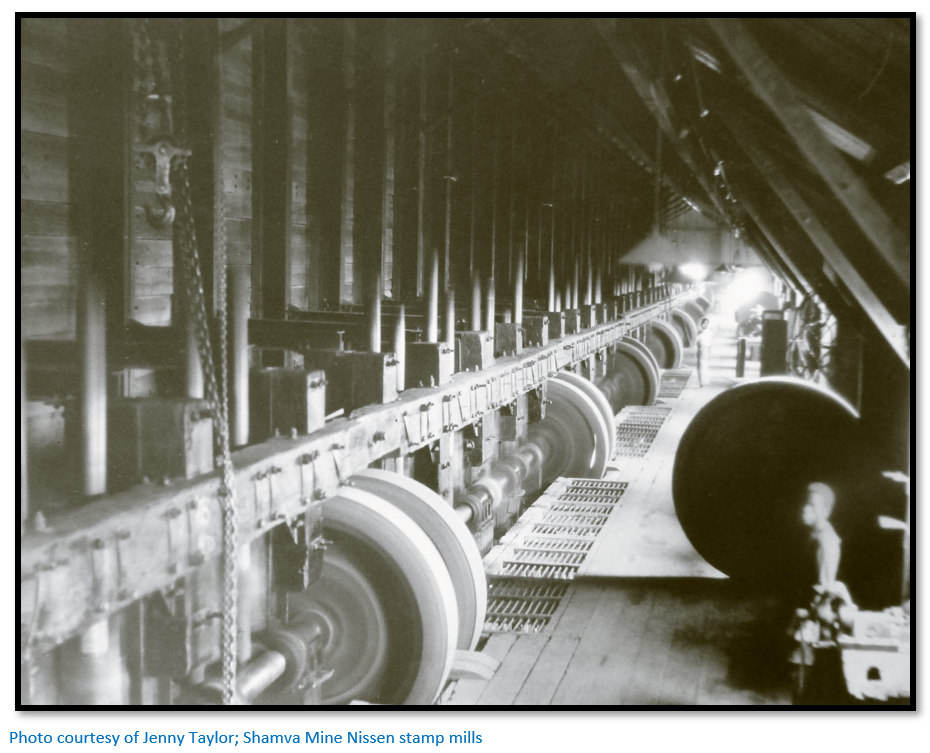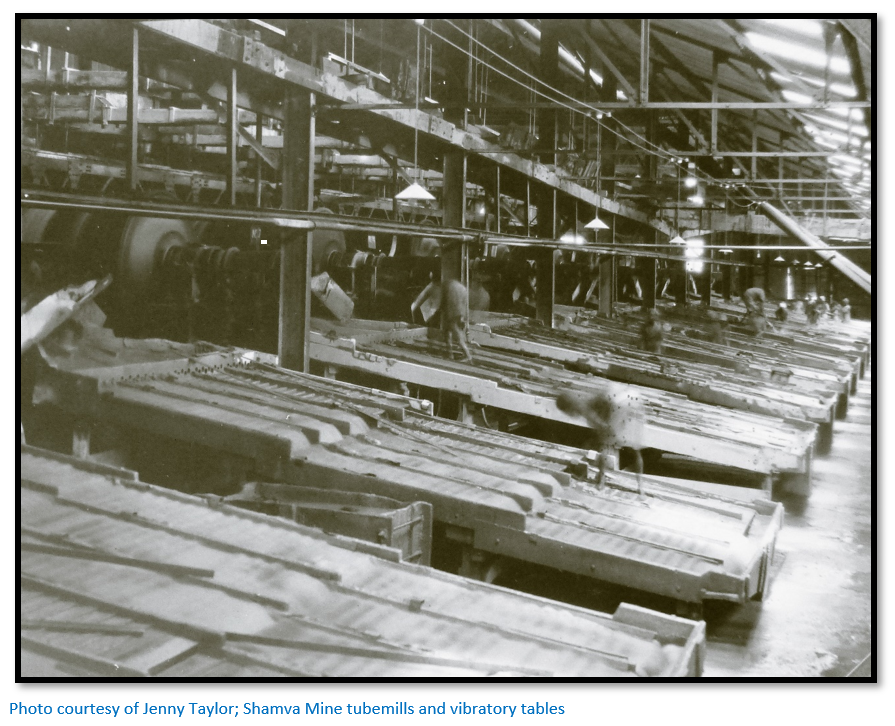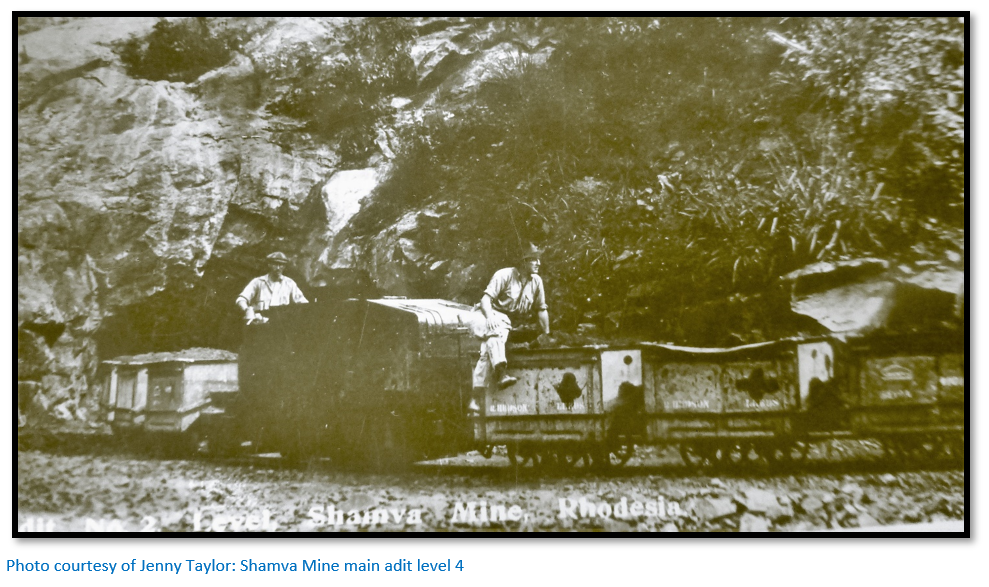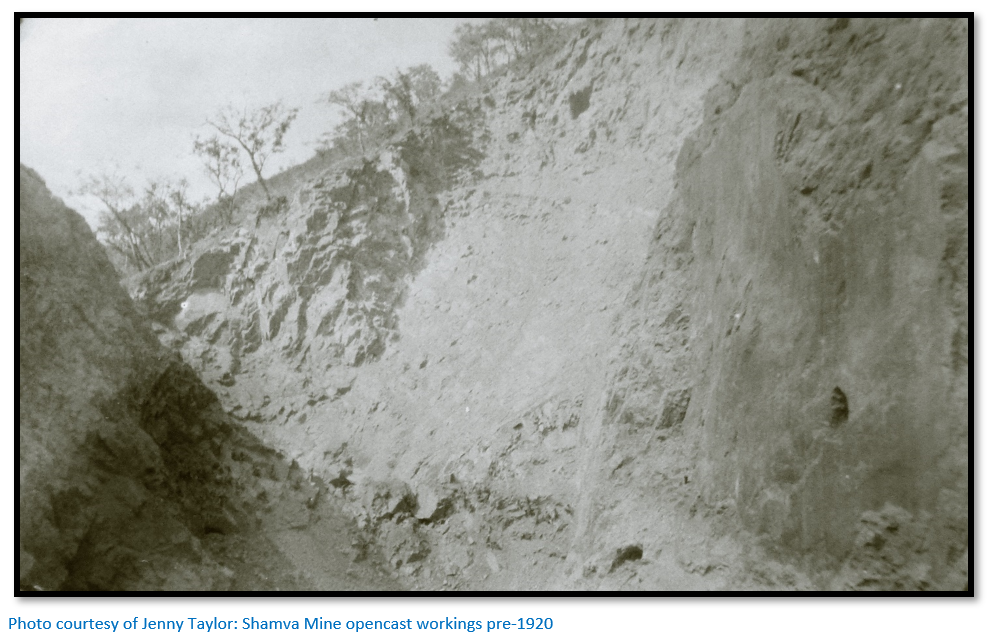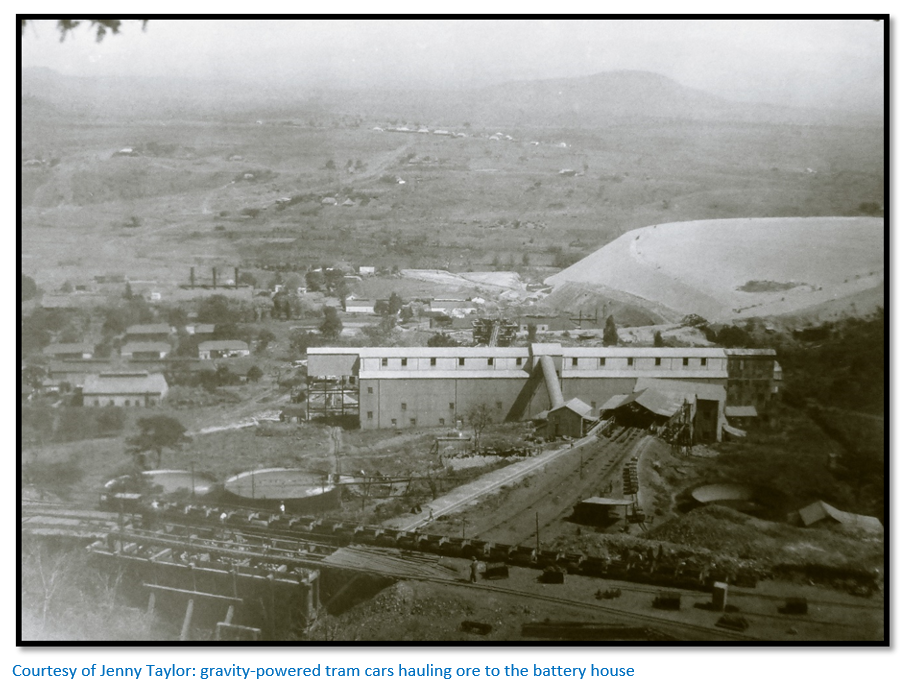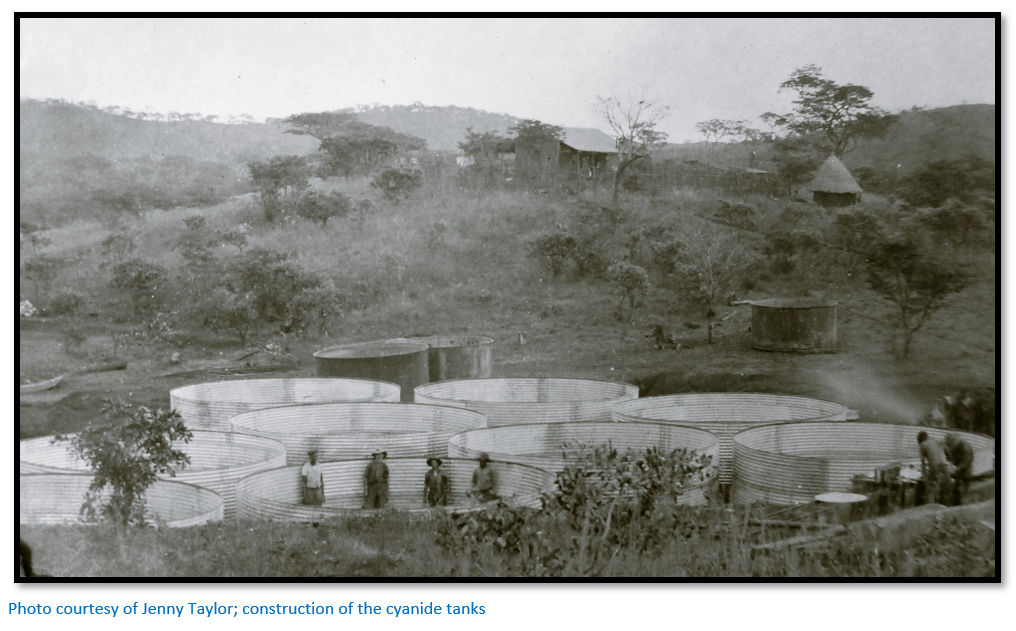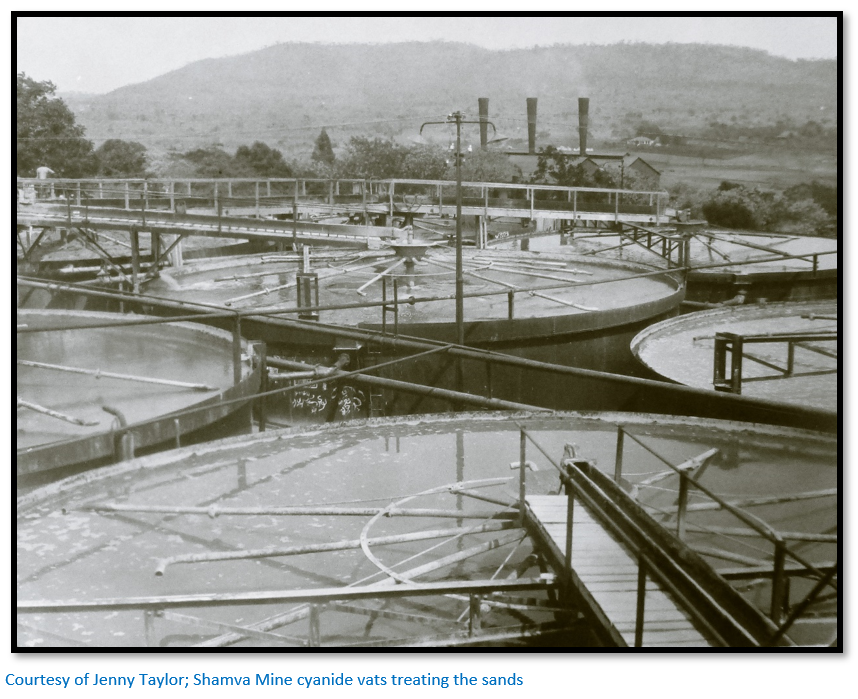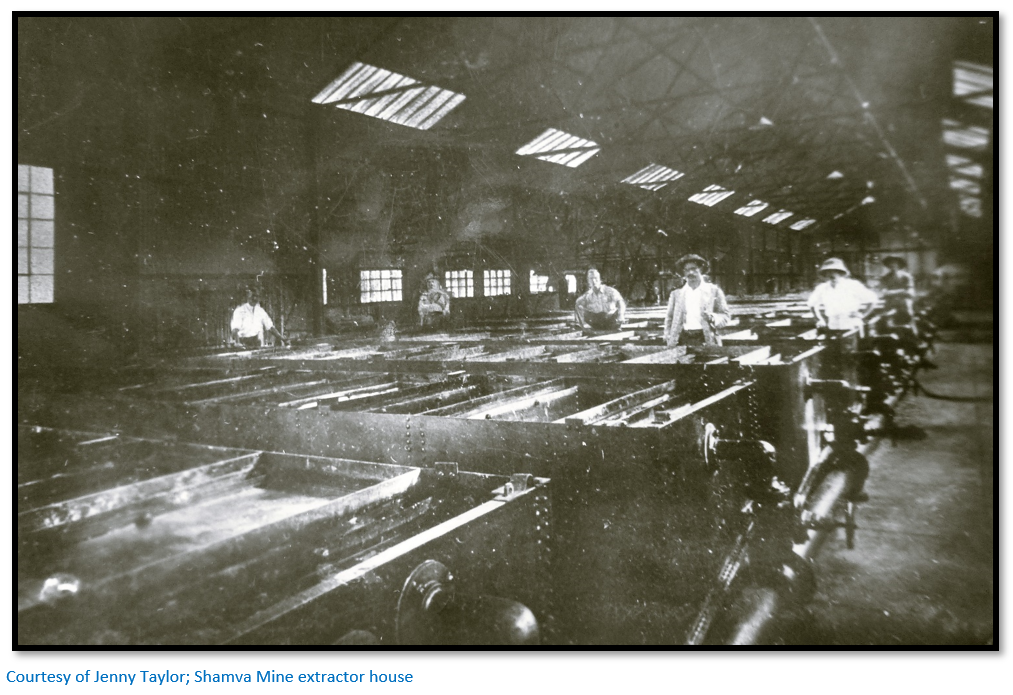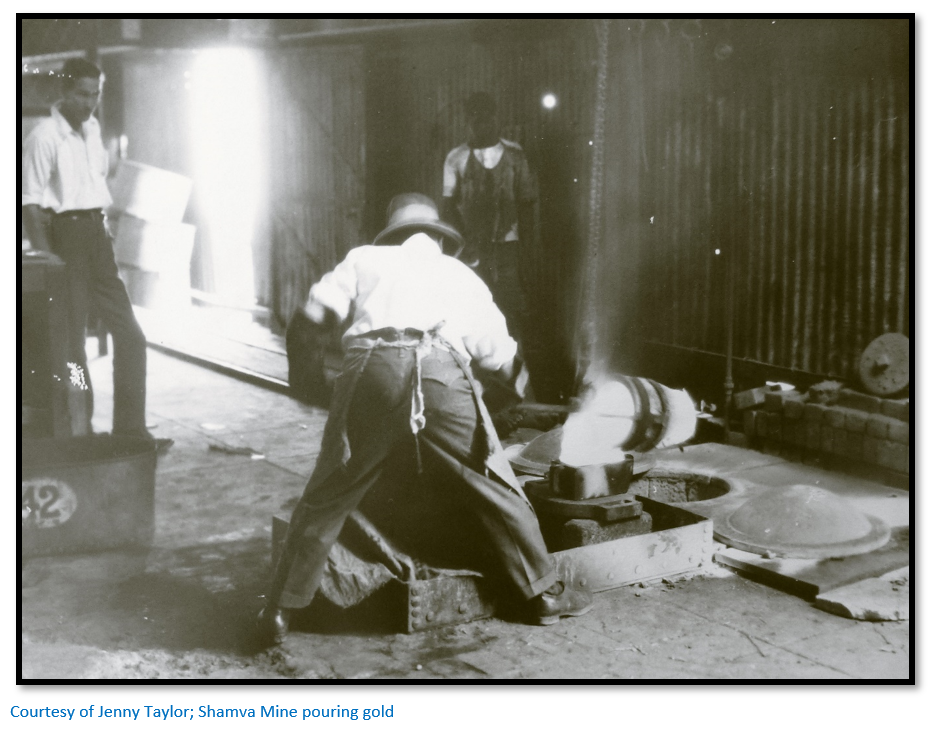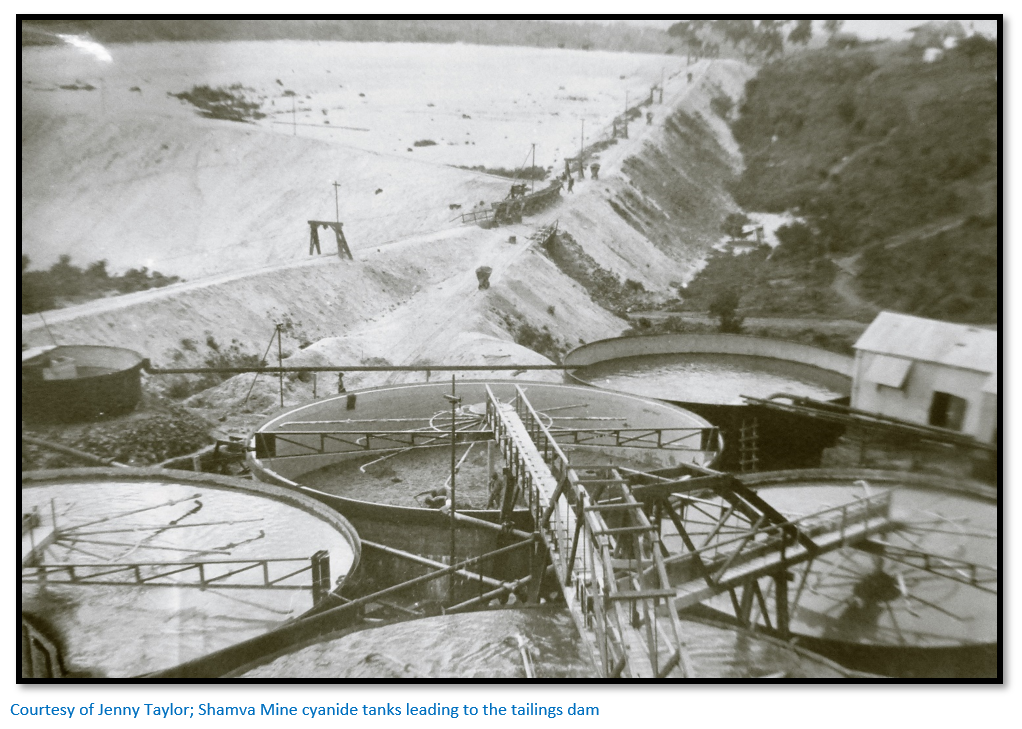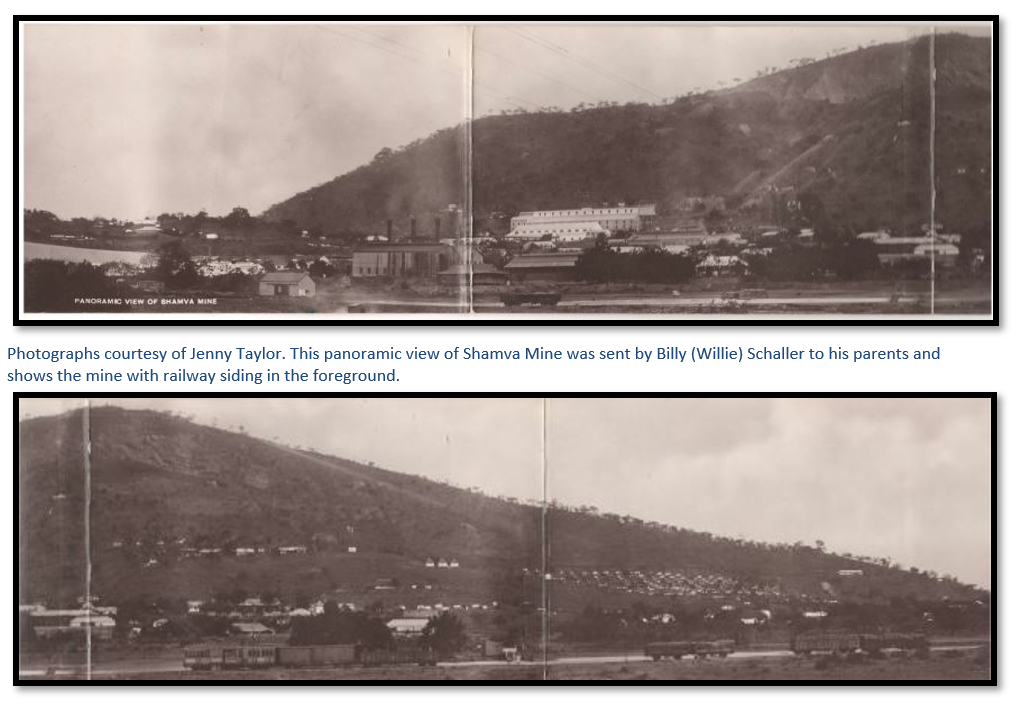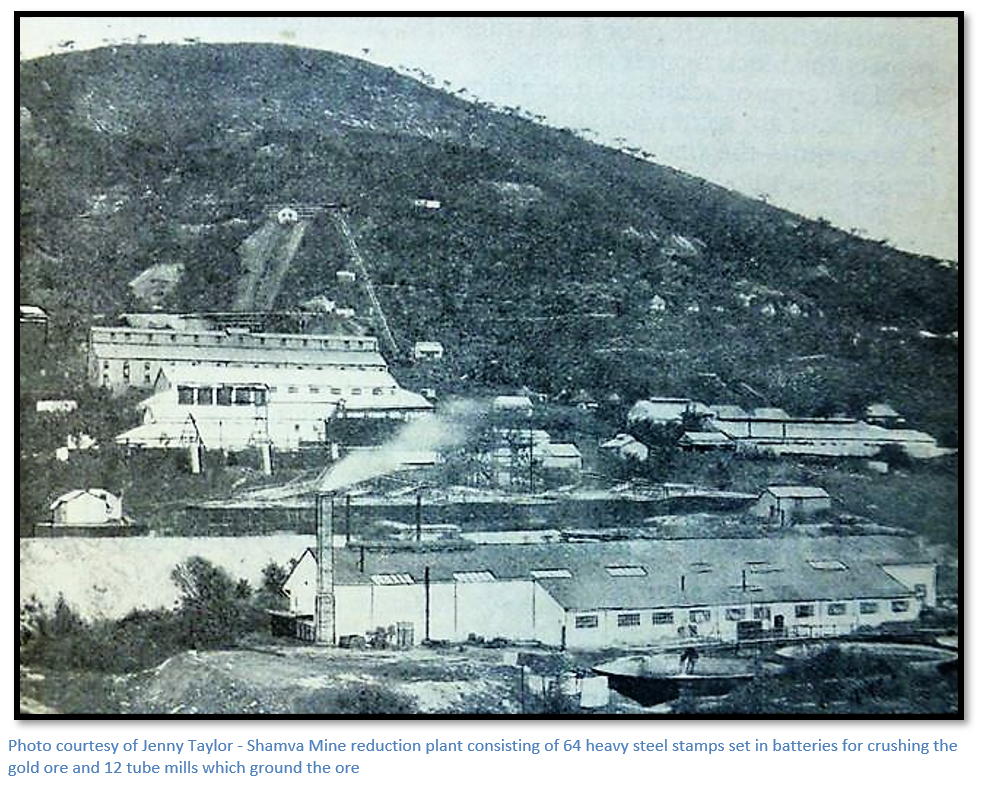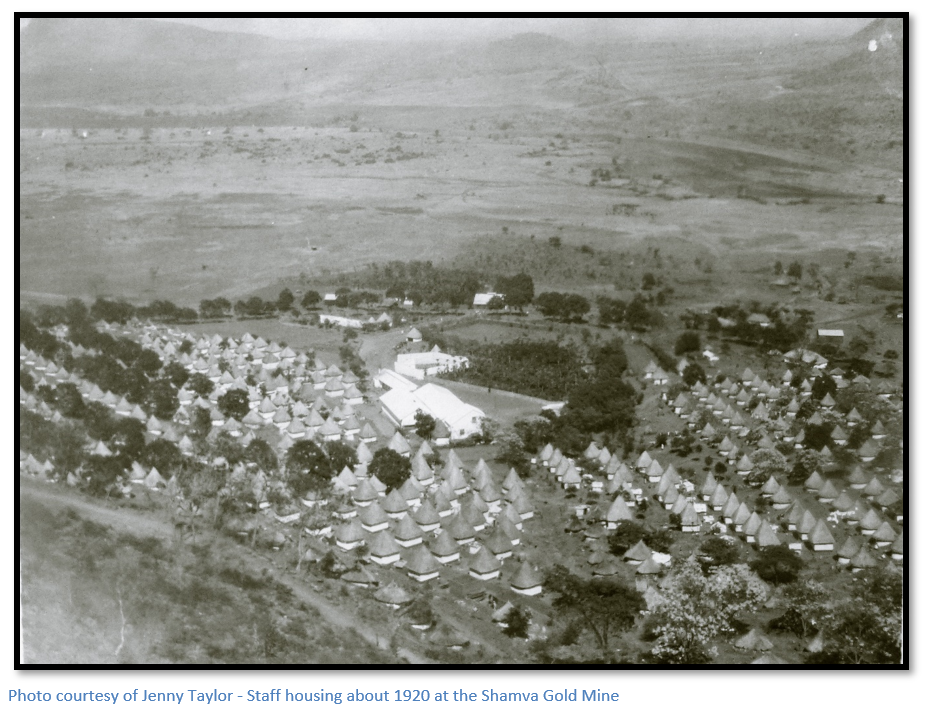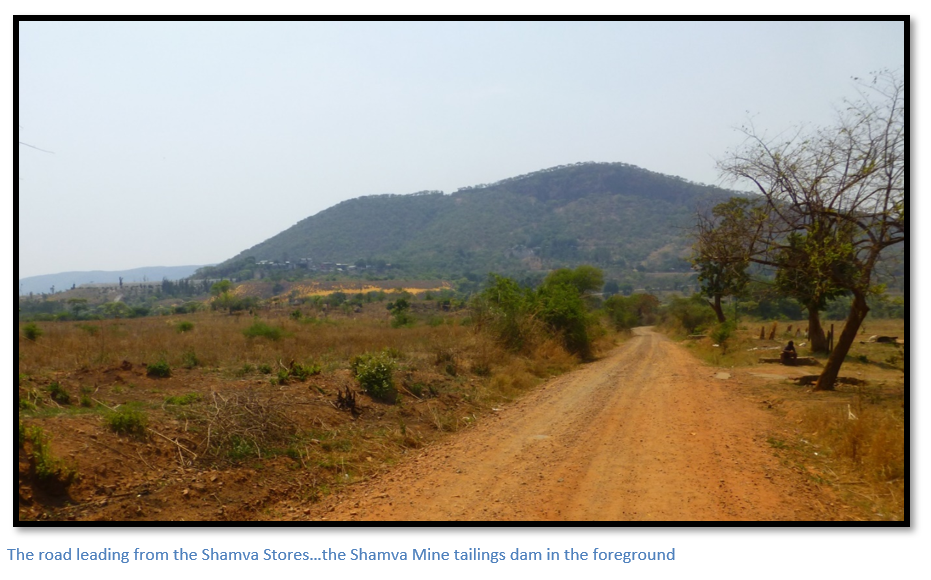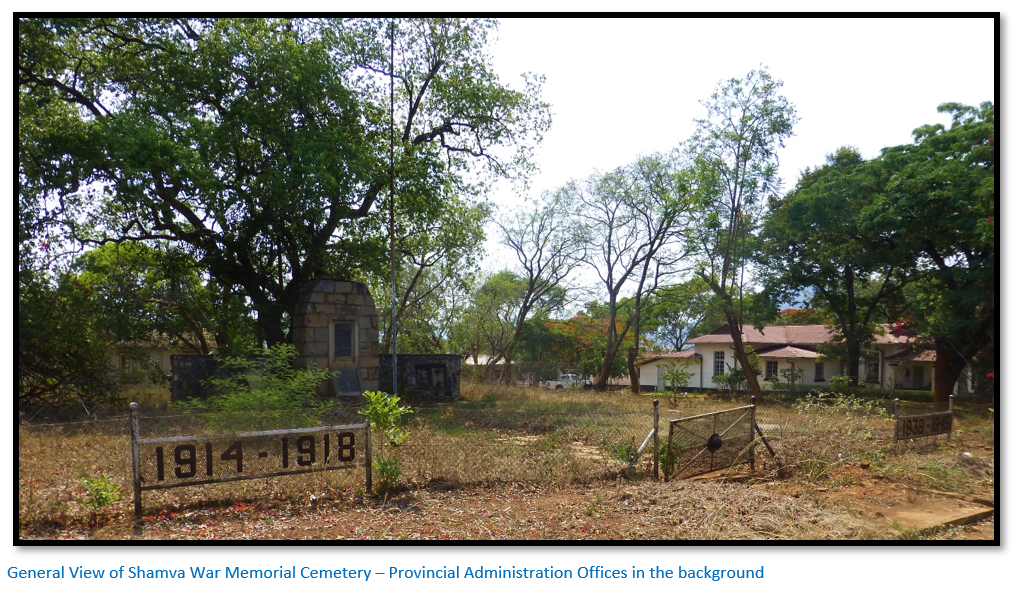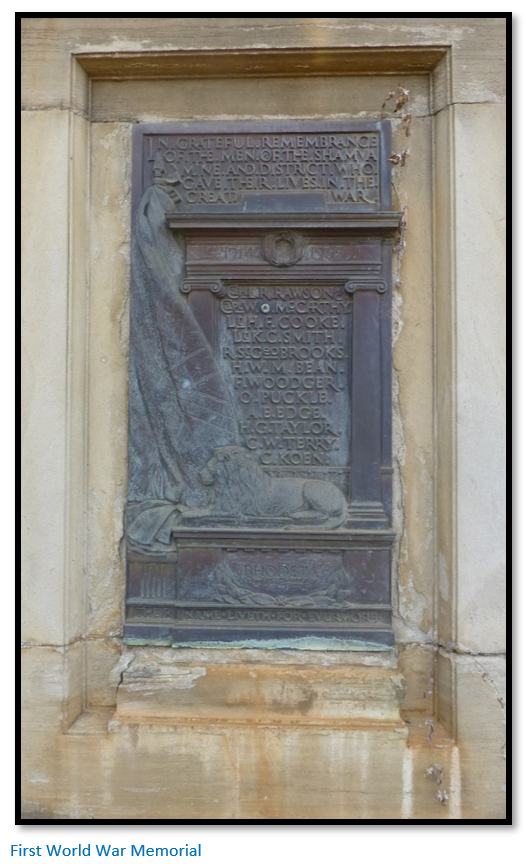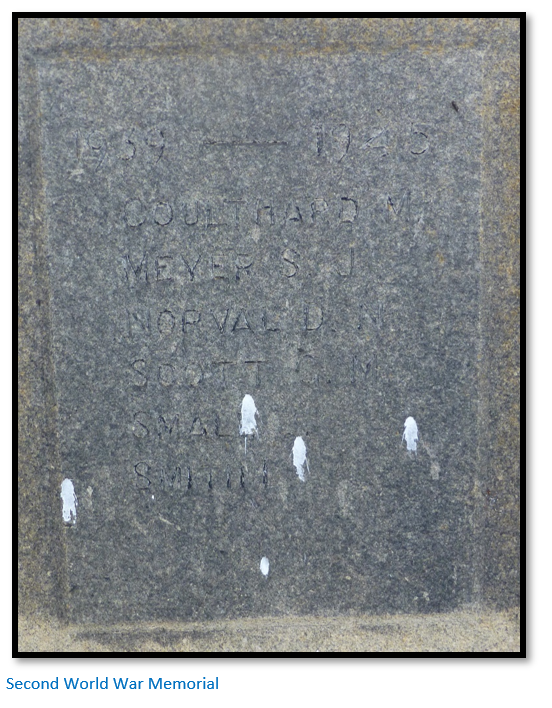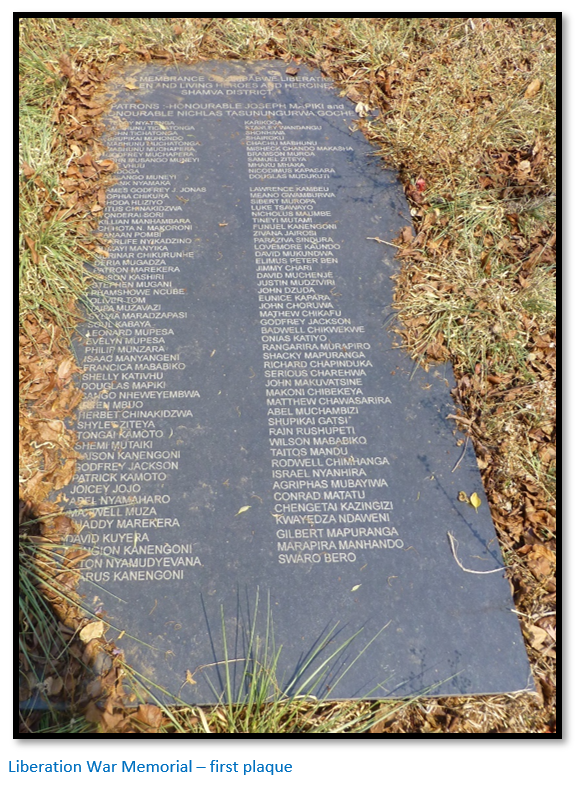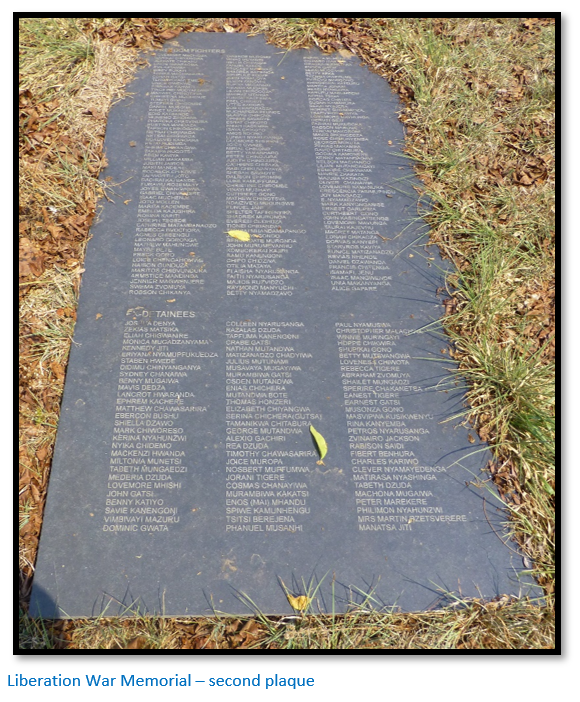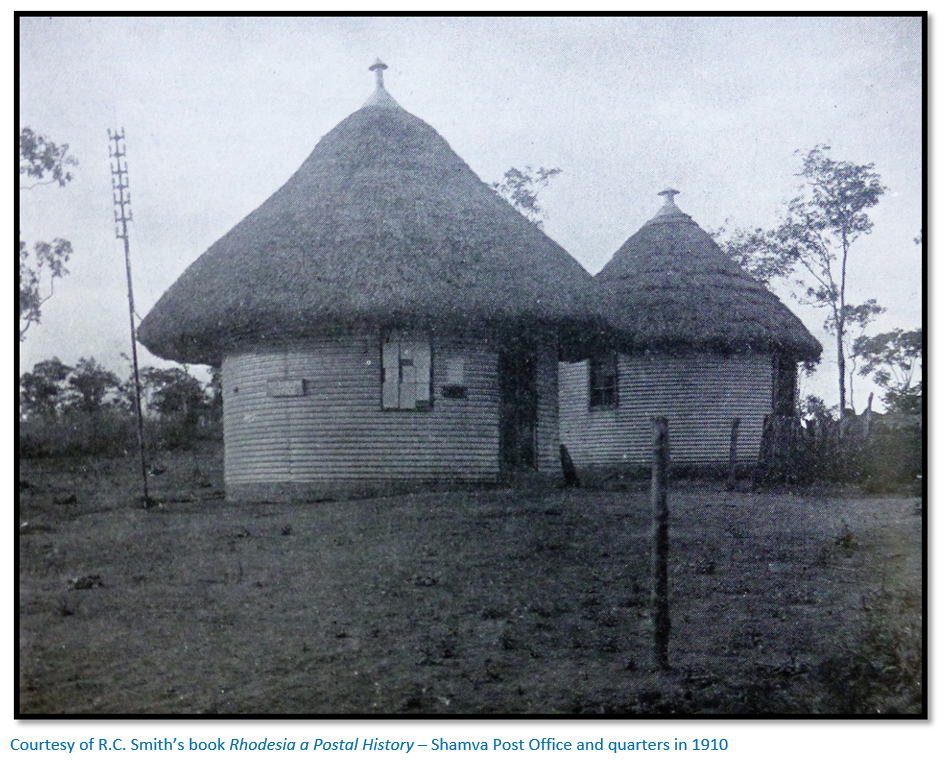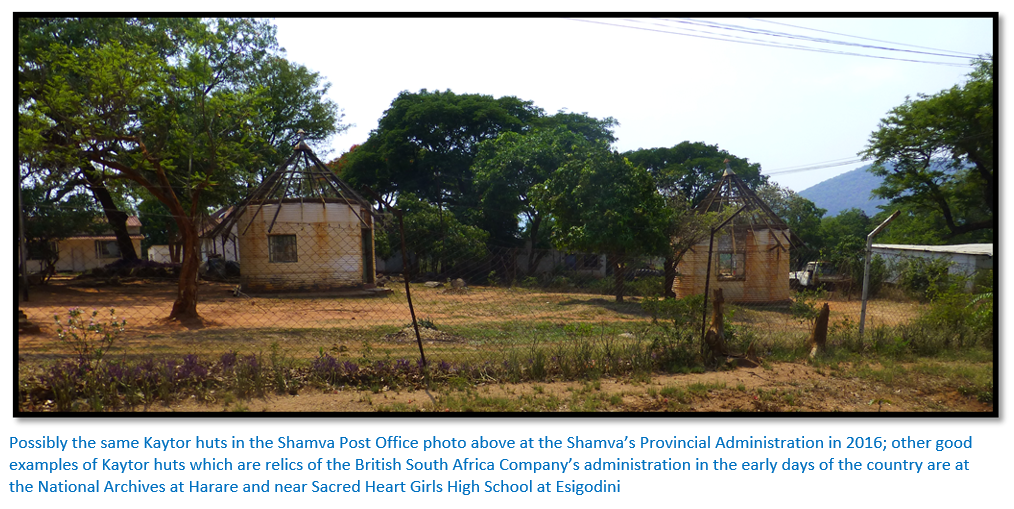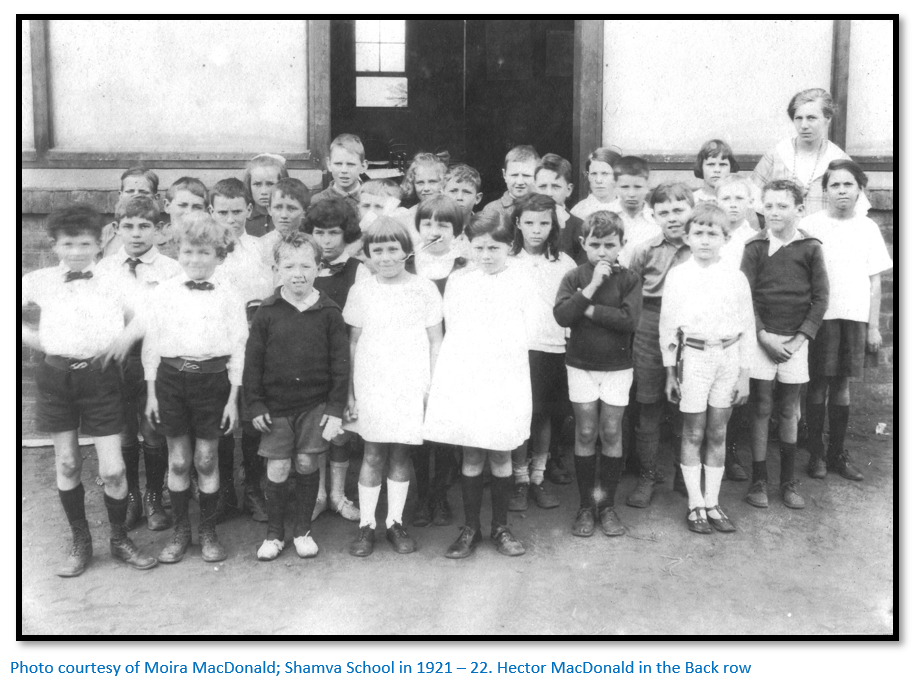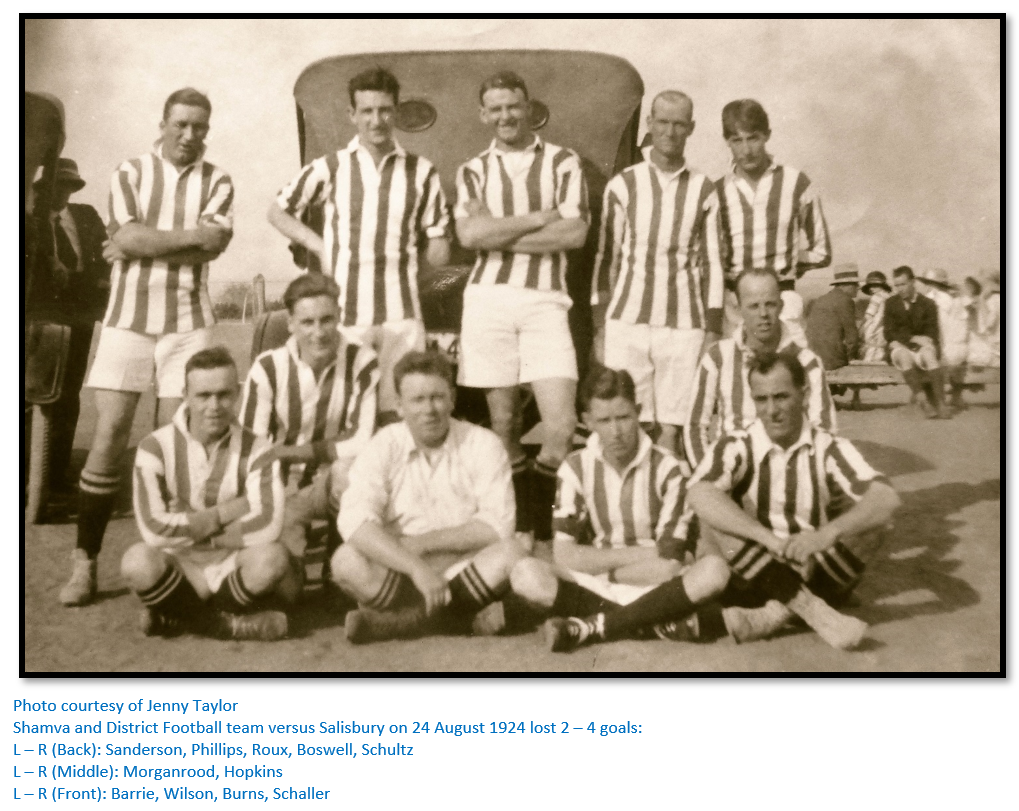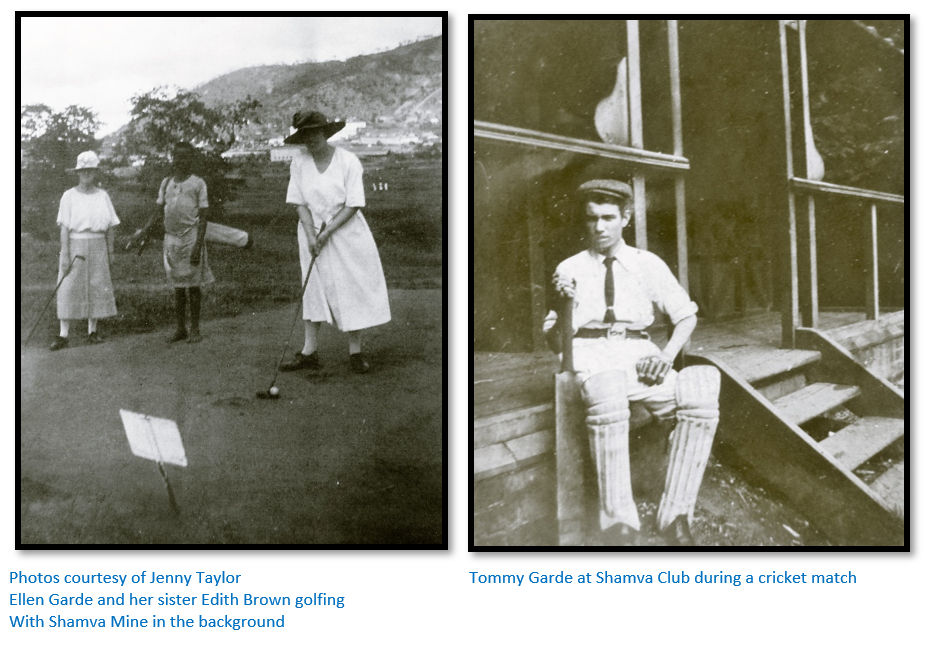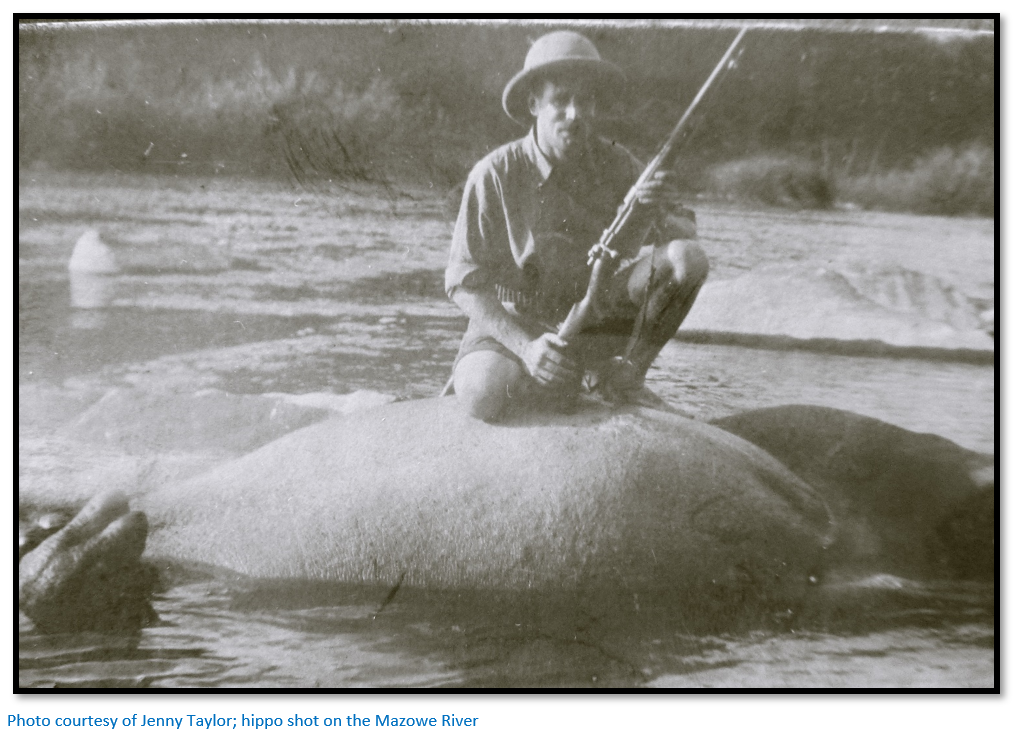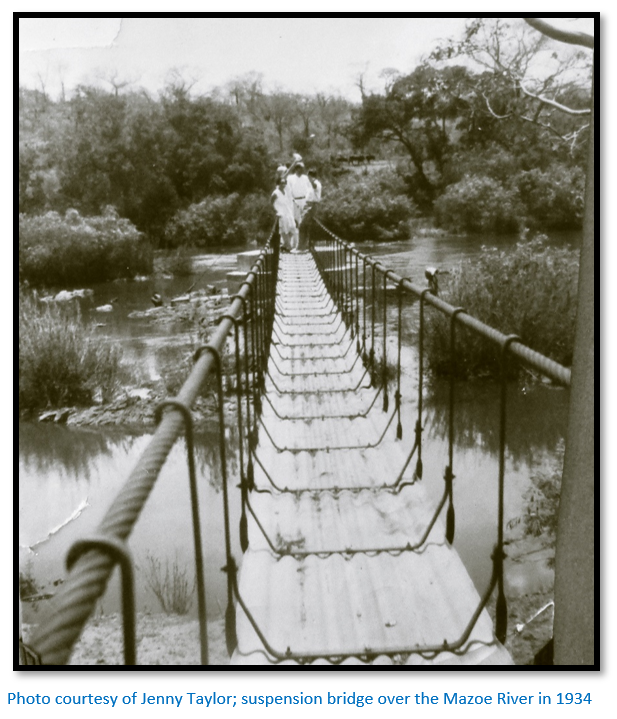Shamva
Take the (A2) Enterprise Road, passing through Newlands and Chisipite and continuing until the tollgates. Distances are from the tollgates. 0.2 KM turn left on the (A13) Shamva Road; 15.4 KM pass Ewanrigg turnoff on the right, 21.6 KM reach Bally Vaughn entrance on the left. 44.0 KM reach Murmurgwe rock art turnoff on the left, 68.8 KM reach the Bindura road on the left and continue on into Shamva. 69.7 KM turn left at the junction, 70.5 KM turn left and pass the War Memorial, then District Administrator’s Offices on the left, ZRP offices on the right, 70.8 KM reach the Shamva Store.
Shamva was originally called Abercorn, after James Hamilton, the second Duke of Abercorn (1838-1913) until sometime between 1909-1913 when the name was changed to Shamva to avoid confusion in the postal system with the town of Abercorn (now Mbala) in Zam
The original settlement in 1891 was a camp near the junction of the Mazowe and Pote Rivers, four kilometres north of modern-day Shamva and just 400 metres west of where the A13 to Madziwa crosses the Mazowe River. Most probably these miners and prospectors were attracted by the tales of numerous old alluvial gold workings on the Mazowe River, as there are numerous sixteenth and seventeenth Century Portuguese written accounts of how the local Africans dived into the Mazowe River during the dry season with wooden dishes and washed the alluvial gold out of the alluvial deposits. These old alluvial gold workings were very extensive along the Mazowe River as far as its junction with the Nyagui River just south of the Umfurudzi Safari Park. The fine gold obtained was stored in porcupine quills and traded with Swahili traders and later the Portuguese based at Tete and Sena, but with subsidiary trading posts based within modern day Zimbabwe. [See my article on Luanze Earthworks and Church under Mashonaland East]
By 1896 a small European community of prospectors and traders had formed to the north of Tafuna Hill at the site of Deary’s Store. It was this group of men who were surprised by the Mashona Rebellion, or First Chimurenga. [The story of their 23 day siege is described in my article The Siege of the Abercorn Store, June 21st – July 13th, 1896 under Mashonaland Central]
A police post was opened near the junction of the Mazowe and Nyaguwi Rivers in 1898 about 20 kilometres north west of today’s Shamva, but malaria and blackwater fever took the lives of the BSAP troopers and in 1912 the police post moved to Tipperary Estate, closer to the A13 and the original settlement. In 1929 the police station was re-sited at its present location in Shamva.
Shamva Mine
The original claims(No 546) were pegged in 1893 by the Glasgow Mashonaland Syndicate on “ancient workings” on what was called Lone Star Hill, William Grimmer being their agent. In typical fashion the little work was done on the original claims, the mineralised zone being called “Star Reef” and they were abandoned and re-pegged (No 1648) in 1906 by Douglas MacAndrew and renamed Shamva.
By 1909 the whole hill was covered in claims. NM Keane and the B and S Syndicate (GB Blackwell, CA Bolas and M. Singer) held some of the most valuable claims and a short lived rush occurred. John Stuart wrote: “Everything has been pegged, and in many instances, I believe if gold is to be found the grass and trees will have to be crushed for assuredly there is none in the ground. It is idle, absurd or wicked to speak of a “New Rand, with one group rapturously describing “Hospital Hill shales” and another claiming “true Barberton” again.”
Twelve months later interest in gold had almost died in the district. The Mont D’Or Mine produced 3.1 kgs, the Mullinger Mine suspended operations and exploration at Button Reef (Le Page’s claims) had stopped. The Joker Mine had stopped milling and the Shamva Mine had a labour shortage.
Speculation overseas continued with great public interest in the district, and the Rhodesian Abercorn Shamva Trust Company issued their shares with such a flourish that they were soon trading at £2 12s 6d; but a week later a mining journalist was writing: “it is becoming increasingly difficult to obtain reliable information on the Abercorn Field. Much to our surprise, especially in view of the title chosen, we are now officially informed that this company has no connection with the Shamva Mine, nor with any companies having a substantial interest in it.” By March 1912 the share values had dropped to 7s 6d, before the company went into voluntary liquidation and the shares became worthless.
Both Edone Anne Logan and Graham Blick tell the story about how in 1909 Goldfields Rhodesian Development Company (GRDC) and the BSA Company competed to register their claims. Goldfields sent a runner from Shamva to Salisbury (now Harare) and the BSA Company sent their application by Zeederberg Coach with the runner reaching the Mining Commissioner’s office first!
Proper exploration then began to take place under JG McDonald who took out additional claim options. A 1910 description said Shamva Hill was perforated with shafts and adits, about 85 in all.
Registration of Shamva Mines Ltd on 5 April 1910 was described as the mining event of the year with the shares much over-subscribed. The Company had a nominal capital of 600,000 in one pound shares; 250,000 of which were issued to Mayo (Rhodesia) Development Company and Abercorn Syndicate Ltd in exchange for their 243 claims on Lone Star Hill.
Further exploration work began near the summit of the hill in what was known as the Prospect Level and after Goldfields consultant, HA Piper, initially identified the following ore reserves:
Within a year, ore reserves had doubled, but the gold content had been reduced to 8.1 grams / tonne and Piper had estimated working costs at 7/6d per ton; this figure proving quite accurate and the mine keeping costs in check until 1925 when they were still 8/10d per ton. European and African wages accounted for 17% and 9% of total expenditure; the tight control on wages undoubtably accounted for industrial unrest at the mine which culminated in the 1927 strike, described later.
Piper noted in Shamva Mine’s favour:
- Large tonnages of ore reserves
- Gravity feed to the mill which reduced haulage costs
- The ore was favourable for machine drilling which reduced mining costs
- The ore reserves were not heavily fractured, resulting in safe mining ground
- Abundant water supplies from the nearby Mazowe River
Disadvantages included:
- No local coal for steam power
- No rail links
Sir Charles Metcalfe who visited Shamva Mine in 1910 stated he was confident the rail link would soon be extended to Mount Darwin and Shamva. Perhaps Sir Charles was interested in Mount Darwin because Rhodes had granted him a large mineral concession in the district! The Mount Hampden to Shamva link via Mazowe and Bindura was completed in April 1913 allowing the transport of heavy machinery.
Preliminary crushing with a 5 Stamp mill had been carried out in 1911 to test results. The new plant was to consist of a power station consisting of steam turbines by Bellis and Morcom with a reduction plant of 56 Nissen Stamp mills and 8 Tube mills; in 1921 increased to 64 Nissen’s and 8 Tube mills. Trial runs began in January 1914 and the plant was commissioned by May. Soon the Shamva Mine employed 135 Europeans and 1,700 Africans and was classed as the largest open-cast mine in the world. In the first 11 months 486,833 tons of ore were crushed with initial ore being taken from the main opencast stope which grew rapidly in size eventually forming a 700 metre long pit, 120 metres at its widest and nearly 170 metres deep. The dust from the blasts became a real hazard in the first rains and caused dangerous mud rushes.
Mining began at the top of Shamva Hill working downwards in 20 separate open stopes, but as they became deeper the stopes gradually joined up into one big pit. DJ Bowen quotes Owen Letcher as saying that the afternoon open pit blast resembled a “volcano in eruption” from a distance! Ground would be broken inwards from the walls and then trammed out through adits at levels 2 and 4 and later 10. In the beginning three petrol-driven locos hauled the trams through the underground workings to bins on the face of the hill, but the ventilation could not cope with the fumes. They were replaced by mules on level 2 that could haul 5 tram cars at a time and worked in shifts of 4 hours, and electric trams on level 4 which hauled trains of 30 trams at a time.
The ore trammed out was tipped into 10 ton gravity skips which took the ore down to the crushing plant near the base of the hill. Primary crushing was done by the Nissen Stamps to 1.3 cm (0.5 inch) with the resultant scree fed to the Tube mills. From here the slurry went onto steeply set vibrating tables (which separate the components of the ore by their specific gravity, density, size and shape) and mercury plates (a metal plate coated with a thin film of mercury on the surface - the gold dissolves into the mercury to form an amalgam)
These processes recovered about one-third of the gold; cyanide recovered the remainder with equipment using thickeners, agitation tanks and filter plant.
Later the Crowe-Vacuum process was installed. The ore slurry solution goes through through diaromaceous earth ,oxygen is then removed by passing the solution through a vacuum de-aeration column and then zinc dust is added which precipitates the gold, silver and copper, if present; zinc having a higher affinity for the cyanide ion than gold. The gold precipitate, mixed with zinc dust, is then filtered out of the solution, and the zinc dust and gold are mixed with sulfuric acid to dissolve the zinc. The solution is filtered, and the remaining solids are smelted to a gold bullion bar.
About 1913 when Lord Abercorn, the BSA Company Chairman, died, the district’s name was changed from Abercorn to Shamva as there was confusion at the Post Office with Abercorn (now Mbala) in northern Zambia.
A 1916 Geological report by Dr G. S. Corstorphine stimulated a search for additional zones of enrichment and surface trenching discovered an additional 600 metres of strike to the east (the Eastern Section) and parallel ore bodies to the south of the Main Opencast (South Parallel Section). The South Parallel West Section was developed into another large opencast, known as the Goromonzi Stope and worked separately. By 1921 development reached the seventh level and work began on an ore body which became known as the No. 7 ore channel.
The geology was very complex. The host rock was originally called the Abercorn Banket Formation, but became known as the Shamvian. Sampling gave very misleading results with this typical observation: “some of the unlikeliest rock carries ounces of gold, and some which you would bet your last shirt on, gives nothing in the pan.” Rarely is there any visible gold, and then only on a cleavage plane. The ore body is a quartzite, with sand stone in the oxidised zone. It contained pebbles of chert, and the gold, running about 6 grams (3.8 dwt) to the ton, is in the matrix, often mingled with pyrites. In the twenties some 54,000 to 56,000 tons were being processed monthly, at a profit of about £12,000.
For much of its life, Shamva Mine along with the Cam and Motor Mine (C&M) and the Globe and Phoenix (G&P) produced one-third of the country’s gold and for periods in the twenties the Shamva had the second largest output after the G&P. The G&P was so rich that dividends of 50% were regularly paid out on a capital of £200,000, and once the company paid a dividend of 120%. Shamva paid out much lower dividends, but by 1930 they totalled £1.8 million, or nearly a 300% return.
In 1927 Shamva Mine became the focus of black industrial militancy. This had started in 1920 with a boycott of white-owned stores, which became a work stoppage in 1922 and the first major strike in Rhodesia which climaxed in 1927 and lasted five days until it was put down with the use of force.
By 1928 the ore in the open cuts on the Main and Eastern sections was running out and all the new ore bodies uncovered by development were unpromising and failed to reveal new ore bodies. At the deepest point of the mine, 60 metres below the tenth level, there were considerable reserves of ore, but their grades were very low and unable to sustain the large monthly tonnage required by the mill, and the mine closed in May 1930.
This had a considerable impact on Shava and the number of Europeans dropped from 493 in 1926 to 66 in 1931 and the whole infrastructure of the district was affected. The Hospital had previously four European sisters and twelve African nurses; the numbers no longer justified these numbers.
Operator | Period | Milled (tonnes) | Gold (kg) | grams / tonne |
Shamva Mines Ltd | 1909 - 1930 | 8,471,961 | 43,337 | 5.1 |
J. Cruikshank / Lone | 1930 - 1931 | 181,488 | 798 | 4.4 |
Star Tribute Ltd | 1931 - 1943 | 128,643 | 460 | 3.6 |
D.C. Forbes | 1943 - 1953 | 64,024 | 182 | 2.8 |
Shamva Tributors Ltd | 1954 - 1957 | 276,528 | 1,144 | 4.1 |
I.E. de Beer | 1959 - 1963 | 615 | 4 | 6.8 |
Rhodesian Selection Trust | 1964 - 1967 | - | - | - |
Homestake Mines - Attica | 1968 - 1994 | 3,931,437 | 15,653 | 4.0 |
Homestake Mines - Independence | 1994 - 1996 | 713,917 | 1,869 | 2.6 |
9,123,259 | 45,925 | 5.0 |
From 1930 to 1937 the Shamva Mine a number of small workers worked the area under tribute, the most well-known being WJ Ludgater, whilst Goldfields (GRDC) periodically produced reports of resuming production. Most of the tributors extracted ore from the mine above the fourth level, or retreated the old sands and slimes dumps, and piles of sulphide concentrate.
In 1964, Rhodesian Selection Trust Exploration Ltd was granted an option on the claims which they retained until 1967 and then in August 1968 Homestake Mines (Pvt.) Ltd. entered into an agreement with the owner. Mr. W. J. Ludgater to work the property. Initial mining and exploration was confined to the Cymric Section, mainly because Rhodesian Selection Trust Ltd. had developed ore reserves in that section, but as the Cymric ore reserves diminished mining began from 1972 in the main section of Shamva Mine where exploration gave encouraging results, but by 1972 mining activity was gradually transferred to the Shamva Mine.
In the early period of the mine's history, development was laid out in a manner suitable for the exploitation of a large ore body with evenly distributed gold values. Haulages on each of the levels were generally driven to the south of the ore channels, the ore zones were then exposed and assessed by cross-cuts at approximately 30 to 60 metre intervals. Most mining was done by underhand stoping from the opencast workings and the ore moved by gravity through winzes to boxes, before being trammed out through a large adit on the second level and the main adit on the fourth level. In 1920 a shaft was sunk from the fourth level to the seventh level. An incline shaft was sunk from the seventh to the tenth level in 1925, and all ore from the seventh level downwards was moved downwards to this level and then trammed to the surface.
However, when the mine re-opened in 1972, the main adit on fourth level and the vertical shaft from fourth to seventh levels were used as the main access ways.
Nathaniel George Thomas “Tommy” Garde was employed at the Shamva Mine as Tin-Smith from 1915 to 1936. He married Nell in 1920 and died at Shamva on 21 June 1936. He had a press at Shamva Mine which was used for rolling out corrugated iron to manufacture the tanks in the cyaniding process.
The photographs above marked courtesy of Jenny Taylor belonged to Willie Schaller and Tommy Garde, who were cousins and who both worked on the Shamva Mine in the 1920’s.
Shamva World War II and Liberation War Memorials
In a refreshingly far-sighted and openhanded gesture of reconciliation the administration and towns people of Shamva incorporated the existing World War I and II war memorials with the Liberation War Memorial commemorating those sons and daughters who fell in the liberation of Zimbabwe. Adjacent to the Provincial Administration Offices we have the two memorials side-by-side in what I think is the only such memorial in the country.
The First World War plinth carries inscriptions: “In grateful remembrance of the men of the Shamva Mine and District who gave their lives in the Great War 1914 – 1918. Rhodesia - their Name liveth for evermore.” Both First and Second War Memorials are of the standard type commonly seen throughout the United Kingdom and Commonwealth.
The Second World War plaque is carved in granite has 1939 – 1945 and six names inscribed although gradually their names are becoming illegible through the natural effects of weathering.
The Liberation War Memorial comprises two slabs of flat granite laid into the ground with the inscription: “In Remembrance of Zimbabwe liberation fallen and living heroes and heroines of the Shamva District.” One plaque lists one hundred and ten names; the other lists one hundred and seventy six names of Freedom Fighters and eighty-six names of ex-Detainees.
Anyone wishing to know if an individual is named can contact me through the website.
Shamva Post Office in 1910
Shamva School in 1921-1922
Shamva Sports activities
It is clear that that the farmers and miners of the Shamva district met often at the Shamva Club to socialise and relax and that sport was an important activity. Local newspapers reported in some detail on cricket and rugby and golfing matches between Shamva district and visiting teams. Below a few photographs from those days.
Shamva Voters Roll in 1922
Thanks to Moira MacDonald who sent the list of names. No senior staff appear to be listed however such as Native Commissioner and no Post Office staff.
Shamva Voters Roll in 1922 |
|
| |
Surname | Forenames | Location | Occupation |
| Administrative |
| |
Dennison | Frederick Weatherley | Shamva | Civil Servant |
Molyneux | Lionel John | Shamva | Civil Servant |
Scott | Arthur Edward Annesley | Shamva | Civil Servant |
Tapson | Rupert Ross | Shamva | Civil Servant |
Fiander | Herbert Gordon | Shamva | Clerk |
Frith | Robert Cozens | Shamva | Clerk |
Rausch | Charles Herman August | Shamva | Clerk |
Trevor | John Rutherford | Shamva Mine | Clerk |
Williams | Harold John | Shamva | Clerk |
Wilson | Joseph | Shamva | Clerk |
Booth | Nelson | Shamva | Secretary |
Duffield | Henry John | Shamva | Secretary |
Aitchison | Albert | Shamva Mine | Secretary, Assistant |
Walls | Christopher John | Shamva Mine | Secretary, Assistant |
|
|
|
|
| Commercial |
| |
Barry | John Edward | Shamva | Baker |
Widdicombe | Frederick William | Shamva | Baker |
Cowie | Robert James | Shamva | Butcher |
Donisthorpe | Alfred Charles | Shamva | Butcher |
Parsons | Arthur Malius | Shamva Stores | Clerk |
Rademan | Theodore Allan | Shamva | Commercial |
Butler | Charles Silaness | Shamva | Contractor |
Fiander | Charles Rose | Shamva | Contractor |
Kennedy | Bruce | Shamva | Contractor |
Millington | Ernest David | Shamva | Contractor |
Smith | Francis | Shamva | Contractor |
Southey | Cornelius van Niekerk | Shamva | Contractor |
Southey | Albert Cornelius | Shamva | Contractor |
McLeay | Walter | Shamva | Grocer |
Graham | Percy John | Shamva | Merchant |
Singer | Morris | Shamva | Merchant |
Weinberg | Samuel Joseph | Shamva | Salesman |
Lear | Adam Dennis | Shamva | Store Assistant |
Braude | Barney | Shamva | Storekeeper |
Ettrick | John Douglas | Shamva | Storekeeper |
Glick | Jacob | Shamva | Storekeeper |
Hassein | Kala | Shamva | Storekeeper |
Lasavsky | Isaac | Shamva | Storekeeper |
Simpson | John Smith | Shamva | Storekeeper |
Stanger | Nathan | Shamva | Storekeeper |
Taylor | Arthur Acton | Shamva | Storekeeper |
|
|
|
|
| Construction and maintenance |
| |
Baker | James | Shamva | Blacksmith |
Bennett | Henry George | Shamva Mine | Blacksmith |
Bezuidenhout | Petrus Theodorus | Shamva | Blacksmith |
Houshold | George Ballie | Shamva | Blacksmith |
McLister | Hugh | Shamva | Blacksmith |
Steele | Alexander | Shamva Mine | Blacksmith |
Thomas | Arthur George Henry | Shamva | Blacksmith |
Tilley | Reginald Henry | Shamva Mine | Blacksmith |
Woodhouse | George | Shamva | Blacksmith |
Henry | George | Shamva Mine | Boiler Maker |
Roodt | Paul James | Shamva | Boilermaker |
Verdon | Alfred Benjamin | Shamva | Boilermaker |
Stewart | Samuel | Shamva | Boilersmith |
Baines | Victor | Shamva | Bricklayer |
Blann | Hugh | Shamva | Bricklayer |
Keys | Herbert H | Shamva | Bricklayer |
Squair | James | Shamva | Bricklayer |
Ardern | Sam Gaskell | Shamva | Carpenter |
Birchall | John Edward | Shamva | Carpenter |
Bruce | John Edward | Shamva | Carpenter |
Cohen | David | Shamva | Carpenter |
Dalrymple | William | Shamva | Carpenter |
Maltby | William George | Shamva | Carpenter |
McGeachie | Joseph | Shamva | Carpenter |
Symons | Henry Thomas | Shamva | Carpenter |
Vincent | Edgar | Shamva | Carpenter |
Young | Alexander | Shamva | Carpenter |
Dreyer | Lucas | Shamva | Electrician |
Hodgson | Sidney Scarth | Shamva | Electrician |
Olver | Obed Lanyon | Shamva | Electrician |
Ulyate | Douglas G | Shamva | Electrician |
Woolford | Norman Montague | Shamva | Electrician |
Sutter | George | Shamva | Engineer |
Trotman | John Price | Shamva Mine | Engineer |
Bowring | Francis Thomas | Shamva | Engineer, Electrical |
Daniel | William Lewis | Shamva | Engineer, Mechanical |
Walker | Alexander | Shamva | Engineer, Mechanical |
Barber | William | Shamva | Fitter |
Clarke | George Henry | Shamva | Fitter |
Cullen | Charles Holly | Shamva | Fitter |
Curtis | John Joseph Seaer | Shamva | Fitter |
Darley | Herbert Garnett | Shamva | Fitter |
Flann | Thomas James | Shamva | Fitter |
Frost | John Wesley | Shamva | Fitter |
Geach | Harold | Shamva | Fitter |
Hawke | Stanley | Shamva | Fitter |
Hopkins | William | Shamva | Fitter |
Jackson | Everard William | Shamva | Fitter |
Martin | William | Shamva Mine | Fitter |
McDonald | John | Shamva | Fitter |
McMeekan | James | Shamva Mine | Fitter |
Middleton | Alexander | Shamva Mine | Fitter |
Peacocke | Carl Alfred | Shamva | Fitter |
Rooney | Thomas | Shamva Mine | Fitter |
Smith | John Patterson Amscott | Shamva | Fitter |
Stanley | David Joseph | Shamva | Fitter |
Stevens | Thomas | Shamva | Fitter |
Story | Harold Fawcett | Shamva | Fitter |
van Eetveld | John Wesley | Shamva | Fitter |
Williams | Bernard Thomas | Shamva | Fitter |
Wright | Douglas | Shamva | Fitter |
Johnstone | William | Shamva | Mason |
Musson | Raymond Coker | Shamva | Mechanic |
Johnstone | Norman Hardie | Shamva | Mechanic |
Cantor | Bertie Charles Moxon | Shamva | Mining Engineer |
Donkin | William (snr.) | Shamva | Mining Engineer |
Mortimer | Arthur | Shamva Mine | Mining Engineer |
Prior | Edward Algernon Blackett | Shamva Mine | Mining Engineer |
Chaplin | Thomas Alfred | Shamva | Moulder |
Coomer | Gordon Richard Ernest | Shamva Mine | Moulder |
Lock | George Thomas | Shamva | Painter |
Potgeiter | Frederick Ernst | Shamva | Painter |
Young | John | Shamva | Pattern Maker |
Cornthwaite | Charles | Shamva | Platelayer |
Cornthwaite | George | Shamva | Platelayer |
Leach | Benjamin | Shamva | Sawyer |
Garde | Nathaniel George Thomas | Shamva | Sheet Metal Worker |
Winster | Henry Lenares | Shamva | Truck Fitter |
Spears | Monroe Benjamin | Shamva | Truck Repairer |
McHutchison | Robert | Shamva | Turner |
Whitehair | Charles | Shamva | Turner |
|
|
|
|
| Education |
| |
Bassett | Harry | Shamva | Schoolmaster |
Blair | Annie Earl | Shamva | Schoolmistress |
Fox-Smith | Louisa Charlotte | Shamva | School Teacher |
Lake | Zaida Frances | Shamva | Teacher |
Thompson | Agnes Ellen | Shamva | Teacher |
|
|
|
|
| Farming |
|
|
Norval | Peter | Arcadia Farm, Shamva | Farmer |
Norval | Charlotte Malcolm | Arcadia Farm, Shamva | Married |
Graham | Joseph | Avilon Farm, Shamva | Farmer |
Taylor | McLellan Thomson | Avilon Farm, Shamva | Farmer |
Howard | John Cecil Guy | Bamboo Creek Farm, Shamva | Farmer |
Bonsor | James | Bonney Farm, Shamva | Farmer |
Bonsor | Caroline | Bonney Farm, Shamva | Married |
Stander | Henry | Carrier's Rest Farm, Shamva | Farmer |
Colborne | Frederick Ernest | Ceres Farm, Shamva | Farmer |
Heberden | Hugh Percy | Chipoli Farm, Shamva | Farmer |
Moubray | John Mitchell | Chipoli Farm, Shamva | Farmer |
Wilson | James Carson | Chipoli Farm, Shamva | Farmer |
Moubray | Margaret | Chipoli Farm, Shamva | Married |
Wilson | Blanche Clementina Moubray | Chipoli Farm, Shamva | Married |
Nickson | Frank | Chiwarika Farm, Shamva | Farmer |
Anderson | John Smith | Coryton Farm, Shamva | Farmer |
Anderson | Feraince | Coryton Farm, Shamva | Married |
Strickland | Cecil Eustace | Lions' Den Farm | Farmer |
Bean | Darcy Willard | Maxton Farm, Shamva | Farmer |
Bean | Gladys | Maxton Farm, Shamva | Married |
Scott | Edward | Ndiri Farm, Shamva | Farmer |
Scott | Dorothy | Ndiri Farm, Shamva | Married |
Dick-Cleland | Thomas Stevenson | Panmure Farm | Farmer |
Edgar | Matthew | Richlands Farm, Shamva | Farmer |
Edgar | Emma | Richlands Farm, Shamva | Married |
Claxton | Mark Douglas | Richlands South Farm, Shamva | Farmer |
Claxton | William Robert | Richlands South Farm, Shamva | Farmer |
Claxton | Margaret Bruce | Richlands South Farm, Shamva | Married |
Hastings | Henry John Churchill | Robin Hood Farm, Shamva | Farmer |
Hastings | Edith Marie | Robin Hood Farm, Shamva | Married |
Stanley-Stollard | Fermington Everard Radcliffe Catesby Digby Chandos | Rushington Farm, Shamva | Farmer |
Wing | Edgar Tryon | Rushington Farm, Shamva | Farmer |
Wing | Phyllis Maud | Rushington Farm, Shamva | Married |
Goddard | Herbert Stanley | Shamva | Farmer |
Goddard | Percy Hugh | Shamva | Farmer |
Thompson | Edward Alfred | Shamva | Farmer |
Thompson | Wilhelmina Francina | Shamva | Married |
Southey | Ivor Henry | Somerville Farm, Shamva | Farmer |
Nash | Edwin Christopher Weston | Wapley Farm, Shamva | Farmer |
Alexander | Walney Peter | Woodlands Farm, Shamva | Farmer |
Farrar | John James | Zomba Farm, Shamva | Farmer |
|
|
|
|
| Financial |
|
|
Levy | Harry | Shamva | Accountant |
Norwood | John Kennedy | Shamva | Book-keeper |
Hamilton | Robert | Shamva | Bank Accountant |
Brent | James Elliott | Shamva | Bank Clerk |
Rannie | Alexander | Shamva | Bank Manager |
Hugo | John | Shamva | Bank Official |
|
|
|
|
| Hospitality |
| |
Putnam | Sidney Walter | Shamva | Barman |
Shanker | Sidney | Shamva | Barman |
Blake | Sidney Francis | Shamva | Club Steward |
Hall | James Edward | Shamva | Club Steward |
Wells | George | Shamva | Club Steward |
Robb | Alexander Morrison | Tafuna, Shamva | Hotel Keeper |
Lea | Jack Eric | Shamva | Hotel manager |
Spicer | William Joseph | Shamva Hotel | Hotel manager |
|
|
|
|
| Medical/A&E/Maternity |
| |
Hunt | Lizzie Ada | Shamva Hospital | Matron |
Carroll | Teresa | Shamva Hospital | Nurse |
Farrar | Ada Elizabeth | Shamva | Nurse |
Nisbet | Christina | Shamva | Nurse |
Sherrin | Dorothy Mary | Shamva | Nurse |
Paxton | Lionel Henry Gregory | Shamva Mine | Medical Orderly |
Jackson | Oswald Egbert | Shamva | Medical Practitioner |
Nielson | George Clement | Shamva | Medical Practitioner |
|
|
|
|
| Mining - Management |
| |
Friend | Leopold | Shamva | Manager |
Bryant | Albert George | Shamva | Mill Assistant |
Roux | Johann Frederick | Red Dragon Mine, Shamva | Mill Manager |
Doveton | Charles | Shamva | Battery Foreman |
Hurlbatt | Charles | Shamva | Battery Manager |
Cummings | Bevan Philip | Shamva | Foreman |
Howard | Edward Harry | Shamva | Foreman |
Venables | James | Shamva | Mine Forman |
Carlow | Anthony Veitch | Shamva | Mine Manager |
Wallace | William | Shamva | Mine Manager |
Davies | John | Red Dragon Mine, Shamva | Mine Owner |
Harrison | Walter Cockrain | Joking Mine, Shamva | Mine Owner |
MacAndrew | Douglas Campbell | New Brixton Mine, Shamva | Mine Owner |
Mutter | Frank Andrew Christopher | Tyrian Mine, Shamva | Mine Owner |
Smith | Walter Patrick | Shamva | Shift Boss |
Stead | George | Shamva Mine | Shop Foreman |
|
|
|
|
| Mining - Works |
| |
Lewis | William Francis | Shamva | Labourer |
McGregor | John Peter Campbell | Joking Mine, Shamva | Labourer |
Macdonald | William | Shamva | Crusherman |
Ford | Jim Arthur | Shamva | Boiler Attendant |
Holmes | Norman Clifford | Shamva | Boiler Attendant |
McGlade | Edward | Shamva | Driver |
Brennan | Patrick | Shamva Mine | Engine Driver |
Hines | Ernest David | Shamva Mine | Engine Driver |
Carlow | Norman | Shamva Mine | Hoist Driver |
Turner | William Thomas | Shamva Mine | Hoist Driver |
Burke | Edward William | Shamva Mine | Amalgamator |
Cremer | Daniel Christian | Shamva | Amalgamator |
Demaine | Alfred Henry | Shamva Mine | Amalgamator |
Murphy | Robert Burland | Shamva | Amalgamator |
Savage | George | Joking Mine, Shamva | Amalgamator |
Smith | Albert Bernard | Shamva | Amalgamator |
van Eetveld | Frank | Shamva | Amalgamator |
de Beer | Rijno | Shamva Mine | Cyanide Manager |
Armstrong | Henry William Talbot | Shamva | Cyanider |
Attwell | Parder Edward | Shamva | Cyanider |
Burger | Bernard Theodor | Shamva Mine | Cyanider |
Chesselt-Major | Sidney Francis | Shamva | Cyanider |
Dennis | Arthur Middleton | Shamva Mine | Cyanider |
Forbes | Dudley Campbell | Shamva | Cyanider |
Garrett | Guy Lance | Shamva | Cyanider |
Hart | Harry Wyatt | Shamva | Cyanider |
Horne | William | Shamva | Cyanider |
Lowenshaw | Michael Christian | Shamva | Cyanider |
Reaney | Cecil Hereward Austin | Shamva | Cyanider |
Roux | Paul Ryk | Shamva Mine | Cyanider |
Scally | Donovan Victor | Shamva | Cyanider |
Smith | George Allen | Shamva | Cyanider |
Attwell | Herbert Garnett | Sahmva | Millman |
Doyle | Jacob | Shamva | Millman |
Flanagan | John Henry | Shamva | Millman |
James | Lord William | Shamva | Millman |
James | Lord William Clarence | Shamva | Millman |
Knight | Charles Robert | Shamva | Millman |
McInnes | Donald | Shamva | Millman |
Morris | Frank Linton | Shamva | Millman |
Phillips | Augustus Meaburn | Shamva | Millman |
Roux | Johann Frederick | Shamva | Millman |
Staunton | Ernest Percy | Shamva | Millman |
Stewart | Gordon Grahame | Shamva | Millman |
Trautman | Cecil | Shamva | Millman |
Vernon | Edwin James | Shamva | Millman |
Walton | Richard Moore | Shamva | Millman |
Yeatman | Edward | Shamva | Millman |
Bean | Dennis Ashburner Willard | Shamva | Miner |
Brotherton | Samuel Parrott | Shamva | Miner |
Collias | Nicolas | Shamva | Miner |
Donald | Andrew George | Shamva | Miner |
Edkins | John | Shamva Mine | Miner |
Fison | William Frederick | Red Dragon Mine, Shamva | Miner |
Franken | Peter Jeffery | Shamva | Miner |
Frost | John Christian | Shamva | Miner |
Hall | Eustace Joseph | Shamva | Miner |
Hay | Percy | Shamva | Miner |
Hill | Harry Hayes | Shamva Mine | Miner |
Hopkins | Alfred | Shamva | Miner |
Howman | John Ramsay | Shamva | Miner |
Landman | Adolf Adrian | Shamva | Miner |
Larsen | Sven Adolf | Shamva | Miner |
Robertson | Peter | Shamva | Miner |
Smith | Colin Campbell | Shamva | Miner |
Smith | Harold Ernest | Shamva | Miner |
Smith | Martin John Cussen | Shamva | Miner |
Southey | Albert Lionel | Shamva | Miner |
Southey | Ernest Robert Smit | Shamva | Miner |
Stewart | George | Shamva | Miner |
van Eetveld | George Petrus | Shamva | Miner |
Wacher | Harry | Shamva | Miner |
Watson | John William | Shamva | Miner |
Peat | Ewan Bryant | Shamva | Mining |
Jones | Daniel Joseph | Shamva | Pumpman |
Wynne | James | Shamva | Rigger |
Mennell | Edward Danery | Shamva Mine | Sampler |
Taylor | Frederick William | Shamva | Trammer |
Hawkins | George | Shamva | Truckman |
Lee | Norman | Shamva | Shift Engineer |
Mitchell | Alexander | Shamva | Shift Engineer |
Attwell | Kimberley Cecil Lennox | Shamva | Shiftsman |
Finch | Alfred Percy | Shamva | Shiftsman |
Flaxman | Thomas | Shamva | Shiftsman |
|
|
|
|
| Policing/security/public safety/law and order |
|
|
Hunt | Frank Musgrove | Shamva | B.S.A. Police |
Quinn | Leonard Vaughan Francis | Shamva | B.S.A. Police |
Quinton | Arthur Edward | Shamva | B.S.A. Police |
Sanderson | William Dennison | Shamva | B.S.A. Police |
Schaller | William Roland Byrne | Shamva | Fireman |
Musson | Alfred | Shamva | Cattle Inspector |
Martin | William Henry | Shamva Mine | Compound Manager |
Montagu | Henry Southey Maclear | Shamva Mine | Compound Manager |
Bentham | Henry William | Shamva Mine | Compound Mgr, Assistant |
Macdonald | Donald | Shamva | Mine Police |
Fisher | Martin | Shamva | Sanitary Inspector |
|
|
|
|
| Prospecting |
| |
Bettany | Lionel George | Shamva | Assayer |
Morgenrood | Sydney | Shamva | Assayer |
Pearless | William Seymour | Shamva | Assayer |
Chase | Arthur Henry | New Brixton, Shamva | Prospector |
de Beer | Jack Eric | Shamva | Prospector |
Mackay | James Matheson | Tain Reef, Shamva | Prospector |
Richmond | Frank George | Shamva | Prospector |
Ruddock | Thomas Bell Niven | Shamva | Prospector |
Russell | George Innes | Shamva | Prospector |
Donkin | William (jnr.) | Shamva | Surveyor |
Mitchell | Lewis | Shamva | Smelter |
|
|
|
|
| Transport |
|
|
Wilkins | Leonard | Shamva | Stationmaster |
Badenhorst | Michael Christian | Shamva | Transport Rider |
van Rooyen | Carolus Godlich | Shamva | Transport Rider |
|
|
|
|
| Family |
|
|
Burnette | Alice Una | Shamva | None |
Wheatley | Dorothy Sophia | Shamva | None |
Barber | Hilda May | Shamva | Companion |
Brown | Edith | Shamva | Companion |
Jones | Naomi | Shamva | Companion |
Adamson | Emilie | Shamva | Married |
Attwell | Ann Peta | Shamva | Married |
Bentham | Bridget Winifred | Shamva Mine | Married |
Bettany | Grace Laura | Shamva | Married |
Blake | Mary | Shamva | Married |
Booth | Jessie | Shamva | Married |
Bowring | Beth | Shamva | Married |
Buchall | Eliza Ann | Shamva | Married |
Burnette | Hagar Jane | Shamva | Married |
Carlow | Lucy Esther Joan | Shamva | Married |
Chesselt-Major | Lillie Florence | Shamva | Married |
Christie | Mary | Shamva | Married |
Clarke | Johanna Helena | Shamva | Married |
Coomer | Mabel Mary | Shamva Mine | Married |
Cornthwaite | Annie Earl | Shamva | Married |
Cornthwaite | Bessie | Shamva | Married |
Cornthwaite | Constance | Shamva | Married |
Cullen | Margaret Dunsmore | Shamva | Married |
de Beer | Sophie Bruce | Shamva Mine | Married |
Demaine | Eliza Ann | Shamva Mine | Married |
Donald | Mary | Shamva | Married |
Donkin | Annie Earl | Shamva | Married |
Donkin | Louisa Agnes | Shamva | Married |
Duffield | Violet May | Shamva | Married |
Fiander | Alma | Shamva | Married |
Fiander | Annie Clementina | Shamva | Married |
Ford | Anna Cecily | Shamva | Married |
Friend | Lena | Shamva | Married |
Frith | Mabel Elizabeth | Shamva | Married |
Frost | Hilda Johanna | Shamva | Married |
Garde | Nellie | Shamva | Married |
Graham | Beckie | Shamva | Married |
Graham | Lily | Shamva | Married |
Harrison | Constance | Shamva | Married |
Hawkins | Ada Louise | Shamva | Married |
Hay | Cecille May | Shamva | Married |
Henry | Christine | Shamva | Married |
Hodgson | Ethel May | Shamva | Married |
Holmes | Caroline | Shamva | Married |
Hopkins | Ruth Myrtle | Shamva | Married |
Horne | Cecilia Agnes | Shamva | Married |
Houshold | Lilias | Shamva | Married |
Howard | Edith Rose | Shamva | Married |
Hurlbatt | Florence Emily | Shamva | Married |
Jackson | Charlotte Louise | Shamva | married |
Jackson | Madeline | Shamva | Married |
James | Emma Laurie Elizabeth | Shamva | Married |
Keys | Martha Johanna | Shamva | Married |
Knight | Catherine Helene | Shamva | Married |
Leach | Emily Elizabeth | Shamva | Married |
Macdonald | Barbara | Shamva | Married |
Macdonald | Minnie | Shamva | Married |
Maltby | Agnes | Shamva | Married |
McGeachie | Alice Una | Shamva | Married |
McLeay | Jessie | Shamva | Married |
McMeekan | Hessie Victoria | Shamva Mine | Married |
Millington | Agnett Henrietta | Shamva | Married |
Mitchell | Dorothy Agnes | Shamva | Married |
Montagu | Lily Rose | Shamva Mine | Married |
O'linn | Jean | Shamva | Married |
Olver | Eileen Margaret | Shamva | Married |
Parsons | Rose | Shamva | Married |
Paxton | Violet Sarah | Shamva | Married |
Peacocke | Alice Una | Shamva | Married |
Phillips | Mabel Jessie | Shamva | Married |
Quinton | Dorothy | Shamva | Married |
Robertson | Mary Louise | Shamva | Married |
Roux | Mary Ruby | Shamva | Married |
Smith | Maria Elizabeth | Shamva | Married |
Smith | Martha Ann | Shamva | Married |
Smith | Nellie May | Shamva | Married |
Southey | Marie Marguerite | Shamva | Married |
Southey | Hillian Coral | Shamva | Married |
Spears | Ellen | Shamva | Married |
Steele | Jean | Shamva | Married |
Stewart | Frances Ada | Shamva | Married |
Stewart | Mary Agnes | Shamva | Married |
Taylor | Gladys | Shamva | Married |
Tilley | Dorothy | Shamva Mine | Married |
Trautman | Claudina Helena | Shamva | Married |
Trotman | Kathleen | Shamva Mine | Married |
van Eetveld | Elsebe Maria | Shamva | Married |
van Rooyen | Martha Johanna | Shamva | Married |
Venables | Mary | Shamva | Married |
Vernon | Emma | Shamva | Married |
Wallace | Mildred Helwyse | Shamva | Married |
Walls | Elizabeth Reid | Shamva Mine | Married |
Walton | Dorothea | Shamva | Married |
Watson | Jane Mary | Shamva | Married |
Wells | Dora Kathleen | Shamva | Married |
Williams | Ellen | Shamva | Married |
Wynne | Mabel | Shamva | Married |
Young | Hilda Clara | Shamva | Married |
Young | Mary | Shamva | Married |
Acknowledgements
Thanks to Jenny Taylor for family photographs of the Shamva Mine
Thanks to Moira MacDonald for the 1922 Shamva School photo and the 1921-22 Voters Roll
www. tannahill.8m.com a website of afro Celtic art
Edone Ann Logan. The Shamva Story. Heritage Publication No. 5, 1985. P17 - 30
D.J. Bowen. Gold Mines of Rhodesia 1890-1980. Thomson newspapers Rhodesia, 1979
Andrew du Toit for information on Shamva Mine
The Geology of the country around Shamva. P.A. Stidolph. Rhodesia Geological Survey Bulletin No. 78, Salisbury 1977.

